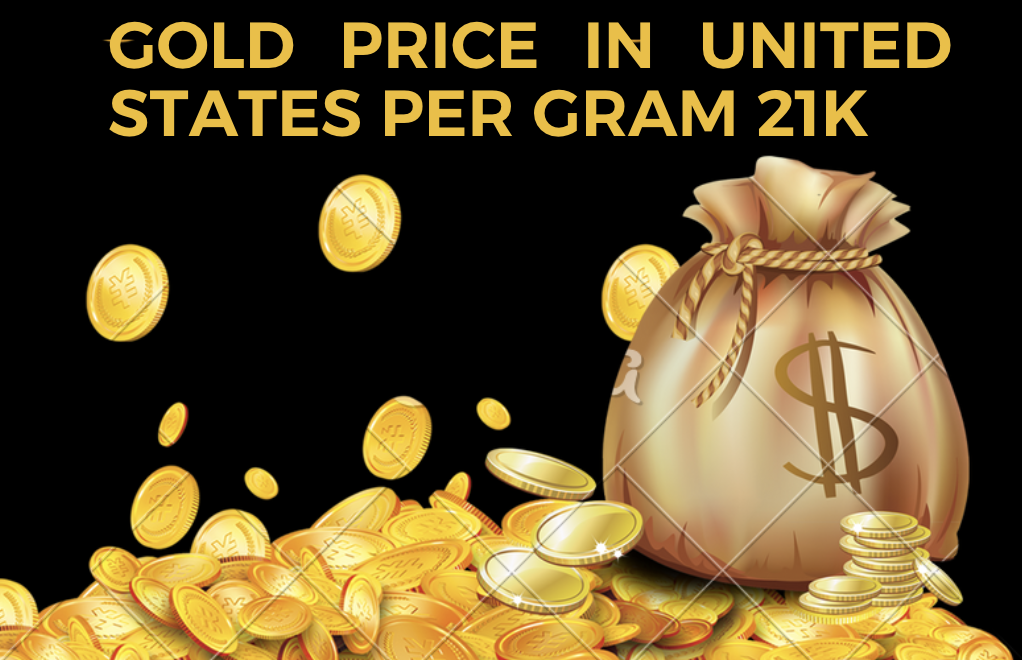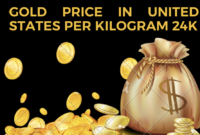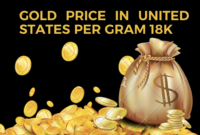Gold Price in United States per Gram 21K – In the world of precious metals, gold holds a position of unparalleled importance. Whether you are an investor, a collector, or simply curious about the current market trends, knowing the price of gold per gram can be essential. This article provides a detailed overview of the current price of 21K gold in the United States. Stay tuned to find real-time updates and historical trends to help guide your decisions.
Gold Price in United States per Gram 21K = 87.95 USD
In this section, we will provide the most recent prices for 21K gold per gram in the United States. Below, you will find a table showcasing the gold price trends for the past 30 days. This information will help you understand the fluctuations in gold prices over time. The latest update is on 02/04/2025.
| Date | Price (USD) | Change |
|---|---|---|
| 02/04/2025 | 87.95 | -0.55 |
| 01/04/2025 | 88.50 | +1.10 |
| 31/03/2025 | 87.40 | +0.90 |
| 28/03/2025 | 86.50 | +1.17 |
| 27/03/2025 | 85.33 | +0.29 |
| 26/03/2025 | 85.04 | +0.22 |
| 25/03/2025 | 84.82 | -0.04 |
| 24/03/2025 | 84.86 | +0.46 |
| 21/03/2025 | 84.40 | 0.00 |
| 20/03/2025 | 84.40 | 0.00 |
| 19/03/2025 | 84.40 | 0.00 |
| 18/03/2025 | 84.40 | +0.36 |
| 17/03/2025 | 84.04 | +0.09 |
| 14/03/2025 | 83.95 | +1.12 |
| 13/03/2025 | 82.83 | +0.80 |
| 12/03/2025 | 82.03 | +0.48 |
| 11/03/2025 | 81.55 | -0.36 |
| 10/03/2025 | 81.91 | +0.18 |
| 07/03/2025 | 81.73 | -0.31 |
| 06/03/2025 | 82.04 | +0.20 |
| 05/03/2025 | 81.84 | +0.49 |
| 04/03/2025 | 81.35 | +0.69 |
| 03/03/2025 | 80.66 | +0.12 |
| 28/02/2025 | 80.54 | -1.20 |
| 27/02/2025 | 81.74 | -0.26 |
| 26/02/2025 | 82.00 | -0.63 |
| 25/02/2025 | 82.63 | -0.09 |
| 24/02/2025 | 82.72 | +0.34 |
| 21/02/2025 | 82.38 | -0.35 |
| 20/02/2025 | 82.73 | +0.35 |
Gold Price Chart for 21K Gold in the United States in USD
For a clearer view of the trends in 21K gold prices, this section presents a detailed chart. The chart visually represents the price movements over the past 30 days, giving you insights into the patterns and shifts in gold prices.
Comparison of 21K Gold Prices with 22K and 24K Gold
In this comparative analysis, we examine how the price of 21K gold stands in relation to 22K and 24K gold. This comparison is crucial for investors and buyers who are interested in understanding the relative value of different gold karats. Below, you’ll find a table displaying the gold prices for 22K, 24K, and 21K over the last 30 days. The latest update is on 02/04/2025. Currency used is USD.
| Date | Gram21K | Gram18K | Gram24K |
|---|---|---|---|
| 02/04/2025 | 87.95 | 75.37 | 100.53 |
| 01/04/2025 | 88.50 | 75.85 | 101.16 |
| 31/03/2025 | 87.40 | 74.90 | 99.90 |
| 28/03/2025 | 86.50 | 74.13 | 98.87 |
| 27/03/2025 | 85.33 | 73.13 | 97.54 |
| 26/03/2025 | 85.04 | 72.88 | 97.20 |
| 25/03/2025 | 84.82 | 72.69 | 96.96 |
| 24/03/2025 | 84.86 | 72.73 | 97.01 |
| 21/03/2025 | 84.40 | 72.34 | 96.48 |
| 20/03/2025 | 84.40 | 72.34 | 96.48 |

Comparing Investments: 21K Gold vs. Silver
Investing in precious metals like gold and silver has long been a strategy for preserving wealth and diversifying portfolios. Both 21K gold and silver offer unique benefits and risks, making them attractive options for different types of investors. This article compares the investment potential of 21K gold and silver, focusing on their historical performance, market dynamics, and investment characteristics.
Historical Performance and Value
Gold, particularly in the form of 21K gold, has historically been considered a reliable store of value. Its price tends to be more stable compared to silver, making it a favored choice during periods of economic uncertainty. Over the past decades, 21K gold has shown strong performance, often outperforming silver in terms of price appreciation and stability.
Silver, while also a valuable precious metal, has experienced greater price volatility compared to gold. Historically, silver prices have shown more dramatic fluctuations, which can lead to higher potential returns but also increased risk. During economic booms, silver often outperforms gold due to its industrial applications, but in times of economic downturns, its value can drop more sharply.
Market Dynamics and Demand
The demand dynamics for gold and silver differ significantly. Gold, especially 21K gold, is primarily driven by investment demand and its use in high-quality jewelry. It is seen as a hedge against inflation and economic instability. During times of economic crisis, demand for gold usually increases, leading to higher prices.
Silver has a dual role as both an industrial metal and a precious metal. Industrial applications, such as electronics and solar panels, make up a significant portion of silver demand. This industrial use can lead to price spikes during periods of high technological advancement or increased industrial activity. However, this industrial demand also means that silver prices are more susceptible to fluctuations in the industrial sector.
Liquidity and Market Accessibility
When it comes to liquidity, gold, particularly 21K gold, tends to be more liquid than silver. The market for gold is larger and more developed, making it easier to buy and sell gold with minimal price impact. This liquidity can be advantageous for investors who need to quickly convert their assets into cash.
Silver, while still widely traded, may not offer the same level of liquidity as gold. The market for silver is smaller, and transactions can sometimes have a larger impact on the price. However, silver can be an attractive option for investors looking for a lower entry point, as silver generally has a lower price per ounce compared to gold.
Volatility and Risk Factors
One of the key differences between investing in 21K gold and silver is their volatility. Gold is generally less volatile than silver, providing a more stable investment over time. This lower volatility can be appealing for conservative investors looking for steady returns and long-term security.
Silver’s higher volatility can result in larger price swings, which can be both an opportunity and a risk. Investors in silver might see substantial gains during bull markets, but they also face the potential for significant losses during downturns. This volatility is partly due to silver’s dual role as both an industrial and precious metal.
Storage and Transaction Costs
When investing in physical metals, storage and transaction costs are important considerations. Gold, particularly in high purity forms like 21K, typically involves higher storage costs due to its value. However, the higher value of gold can sometimes offset these costs.
Silver, on the other hand, is less expensive per ounce, which can make storage costs relatively lower. However, because silver takes up more space per dollar of value compared to gold, large holdings of silver can still incur significant storage costs.
Investment Diversification and Portfolio Strategy
Both 21K gold and silver can play valuable roles in a diversified investment portfolio. Gold is often used to hedge against inflation and economic instability, providing a safe haven during uncertain times. Its stability makes it a popular choice for long-term investors seeking to preserve wealth.
Silver offers a different set of benefits, including potential for higher returns during economic expansions and technological advances. Its lower price point can also make it accessible to a broader range of investors, offering opportunities for those looking to invest in precious metals without committing as much capital.
Recent Trends and Future Outlook
Recent trends have seen gold outperforming silver in terms of price growth and stability. However, silver’s potential for higher returns during periods of economic growth or technological innovation makes it a compelling option for investors willing to accept higher risk.
Looking forward, both gold and silver are likely to remain important components of investment portfolios. Investors should consider their individual financial goals, risk tolerance, and market outlook when deciding between 21K gold and silver.





